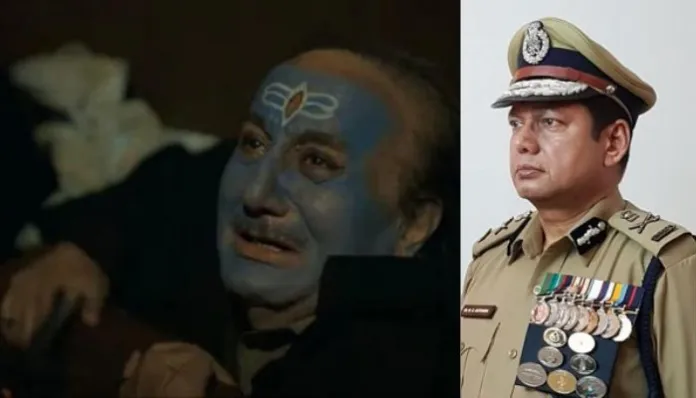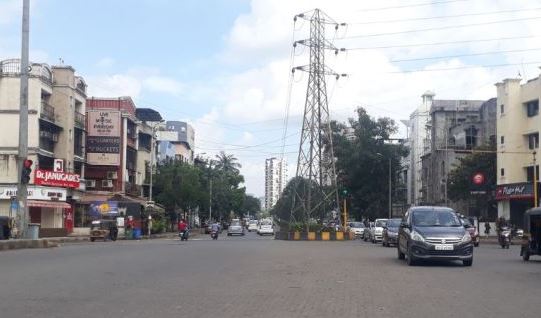India
The reality of Kashmirs brutalities according to a retired IPS officer

After seeing The Kashmir Files, retired Indian Police Service officer and author Dr. NC Asthana wrote a poignant letter. He resorted to Twitter to say that the heinous violence that engulfed Kashmiri Hindus in the 1990s was scarier than what was depicted in the film. He has also mentioned the atrocities of Hindus in Jammu and Kashmir that occurred years after the Pundit genocide and have since been forgotten by history.
“Anyone who has any objections to the censor-approved Kashmir Files is free to boycott it or make another video to counter it,” he said on Twitter. When he was stationed as an officer in the region, he told about his time in the valley. “I’ve worked in Kashmir in sensitive and responsible roles since the early 1990s, and I know the truth is scarier than what is depicted,” he continued. He bemoaned the fact that he and many of his colleagues, who happen to be Kashmiri Pundits, are unable, to tell the truth about the genocide because they are obligated by the Official Secrets Act. The Secrets Act prohibits government officials from disclosing information about security, defense, or other matters that can jeopardize national security.
“Government is a catastrophe in that regard.” Only an artistic version, not an official one, will be available to the public,” he noted. According to him, there are three elements to Kashmir militancy: military, which manifests itself in attacks on security forces and police. The second is insurrectional, which aims to organize bandhs, strikes, and other protests. Targeted attacks on civilians and members of other communities, particularly non-Muslims, are included in the communal dimension.
The project of Islamic Militancy in Kashmir is ongoing. Hindu genocide in 1990 was certainly not an isolated incident. A principal and a school teacher at the Government Boys Higher Secondary School in Srinagar were shot to death in October 2021 after Muslim and non-Muslim instructors were separated. Makhan Lal Bindroo, 68, was working alone in his pharmacy in Srinagar when he and two other civilians were slain by Islamic militants.
Following the 1990 Kashmiri Hindu Genocide, Asthana listed massacres in which innocent Hindus were killed by Islamic violence in the J&K region.
The Wandhama Massacre took place in 1998.
In the winter of 1998, 25 Hindus were brutally murdered in Wandhama, a community near Ganderbal in J&K, including four children and nine women. The attack was claimed by Lashkar-e-Taiba and Hizbul Mujahideen. According to eyewitness evidence, gunmen masquerading as Indian Army troops went to Hindu homes for tea and then shot them with Kalashnikov weapons. The next day, when Kashmiri Hindus assaulted the gates of the National Human Rights Commission in Delhi, at least eleven people were injured by police water cannons.
Amarnath pilgrims were massacred in 2000.
On August 1-2, 2000, 89-105 worshippers were killed in Amarnath during the pilgrimage yatra. In addition, approximately 62 persons were injured in five separate attacks planned by separatist militants in the districts of Anantnag and Doda. Later, on July 20, 2001, when the Amarnath Yatra began in the Shravan month, 13 people were killed and 15 more were injured at a pilgrim camp near Sheshnag lake.
Attacks on Jammu’s Raghunath shrine
In March and November of 2002, two fidayeen attacks occurred at Jammu’s old Raghunath temple. Two suicide bombers assaulted the shrine on March 20, 2002. There were 11 individuals killed, including three security personnel who were shot at the door, and 20 people injured. On November 24, two suicide bombers stormed the temple and hurled hand grenades at devotees, making it the temple’s second attack in the same year. The attack killed 14 Hindu worshipers and injured over 45 others.
Hindus were massacred at Qasimnagar in 2003.
Islamic terrorists dressed as Hindu saints massacred 29 Hindu laborers at Qasim Nagar, on the outskirts of Jammu city. Two blind beggars, 13 women, and one child were among the poor laborers massacred by AK-47 firearms while listening to an India-Pakistan match commentary on a radio set.
Massacre of Nandimarg, 2003
Lashkar-e-Taiba militants killed 24 Kashmiri Hindus in the Pulwama district during the atrocity. Terrorists disguised in Indian military clothes arrived around midnight for the attack. Following the killing, only a few Hindus who remained in the area left.
2006 Doda Massacre
On the night of April 30, 2006, terrorists fired down 22 unarmed Hindus, largely shepherds or their families, in Thawa hamlet in Doda district. Terrorists kidnapped and killed 35 Hindu shepherds in the nearby Lalon Gala hamlet in Udhampur district on the same day.
Latest News
CIDCO Auction Sees Lukewarm Response as Developers Cite High Base Rates

The latest City and Industrial Development Corporation (CIDCO) auction of plots in Navi Mumbai drew a surprisingly muted response on Tuesday. Out of 47 residential, commercial, and service industry plots offered under Scheme 40, only 15 received qualified bids, with 22 plots receiving no bids at all.
Developers attribute the poor turnout to high base rates set by CIDCO, which they claim do not reflect current market realities. Despite mega-projects like Navi Mumbai International Airport usually driving up property demand, the high prices deterred interest. Plots in New Panvel, Panvel East, Airoli, and Ghansoli failed to attract bidders.
Prominent developers, including Godrej Properties, Satyam Lifescapes, and Abhinandan Builders, secured the few accepted bids. Godrej Properties bought three adjoining plots in Kharghar’s Sector 5A for ₹716.58 crore, where they plan to develop a residential community.
Builders Association of Navi Mumbai (BANM) President Vasant Bhadra criticized CIDCO for being out of touch with the market, while others urged CIDCO to rethink its pricing policies.
However, CIDCO’s vice-chairman Vijay Singhal dismissed the concerns, claiming the auction results were positive, with bids exceeding base prices by 21% to 118%. CIDCO has since announced Scheme 41, offering 33 additional plots.
Latest News
Notorious Shooter Arrested in Assassination Plot Against Salman Khan

In a major breakthrough, Navi Mumbai Police, with assistance from Panipat Police, arrested Sukhbir Balbir Singh, alias Sukha, a notorious member of the Lawrence Bishnoi gang, on Thursday. Sukha is one of the prime suspects in a plot to assassinate Bollywood actor Salman Khan. The police traced him to a hotel in Panipat, where he was apprehended.
Sukha had reportedly conducted reconnaissance of Khan’s Panvel farmhouse as part of the plot. The Lawrence Bishnoi gang had placed a Rs 25 lakh bounty on the actor’s life, according to a charge sheet filed by Navi Mumbai Police.
Investigations revealed that 60 to 70 gang members had been tracking Khan’s movements between August 2023 and April 2024. Sukha is the sixth suspect arrested in the case, joining five others previously caught.
The gang aimed to procure advanced weapons from Pakistan, including AK-47s and M16 rifles. Sukha reportedly negotiated the arms deal with a Pakistan-based dealer via video call. The plot was foiled after a tip-off led to the arrest of key suspects.
Sukha, who also maintained an active social media presence flaunting weapons, is now in police custody, with further arrests expected as the investigation continues.
Latest News
In Advance Of The Assembly Elections, Unauthorized Banners Were Taken Down

Unauthorized banners removed ahead of Assembly Elections.
The Bannners
With the Model Code of Conduct coming into effect for the 2024 Assembly Elections on October 15, Navi Mumbai residents have finally seen the removal of unauthorized banners cluttering the city’s public spaces. Both municipal authorities and political parties have swiftly acted to clear streets and chowks of these banners following the Election Commission’s declaration.
In the lead-up to the elections, political candidates organized several events and marches, leading to a surge in unauthorized banners. The issue worsened during this year’s Ganeshotsav and Navratri festivals, with political workers placing banners in various public locations.
Although the Navi Mumbai Municipal Corporation (NMMC) typically releases complaint numbers to address such illegal installations, enforcement has often been weak. Municipal employees have been hesitant to act against political leaders, leaving these banners in place for extended periods. This reluctance led to growing frustration among residents, who viewed the banners as an eyesore and a violation of public space.
Now, with the Assembly Elections approaching and the Model Code of Conduct in place, the city has seen rapid action to ensure compliance, bringing a sense of relief to many residents concerned about the visual pollution caused by political banners.
-

 India2 years ago
India2 years agoAs the arrangement with Prashant Kishor falls through Rahul Gandhi has gone overseas again and is uncontactable
-

 Fact Check4 years ago
Fact Check4 years agoNidhi Razdan, fake Harvard professorship, and here is the explanation through her blog.
-

 Latest News3 years ago
Latest News3 years agoTata wins Air India with ₹18,000 crore bid
-

 Technology3 years ago
Technology3 years agoBSNL reveals all new 4G plans starting at ₹16
-

 Latest News3 years ago
Latest News3 years agoGovernment has spent ₹9,725 crores on Covid-19 vaccination drive so far
-

 Latest News3 years ago
Latest News3 years agoJharkhand government cuts Petrol price by massive ₹25 a litre but with a catch
-

 Navi Mumbai3 years ago
Navi Mumbai3 years agoNavi Mumbai civic body raids and tests morning walkers, many found COVID positive
-

 Latest News3 years ago
Latest News3 years agoRaj Kundra Gave ₹25 Lakh Bribe to Mumbai Crime Branch to Avoid Arrest
















